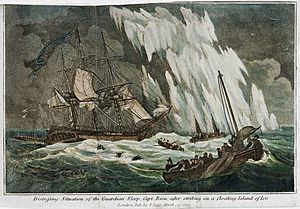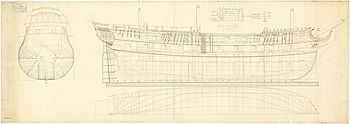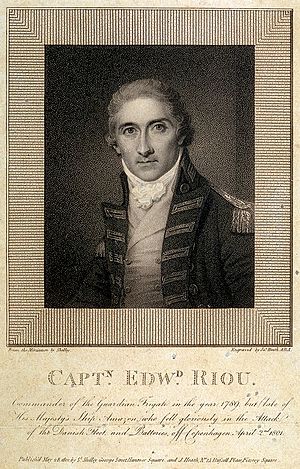HMS Guardian (1784) facts for kids

Distressing situation of the Guardian sloop, Capt. Riou, after striking on a floating Island of ice
|
|
Quick facts for kids History |
|
|---|---|
| Name | HMS Guardian |
| Ordered | 11 August 1780 |
| Builder | Robert Batson, Limehouse |
| Laid down | December 1780 |
| Launched | 23 March 1784 |
| Completed | By 20 May 1784 |
| Fate |
|
| General characteristics | |
| Class and type | 44-gun Roebuck-class two-decker fifth rate |
| Tons burthen | 896 33/94 bm |
| Length |
|
| Beam | 38 ft 2.5 in (11.6 m) |
| Depth of hold | 16 ft 4 in (4.98 m) |
| Propulsion | Sails |
| Sail plan | Full-rigged ship |
| Complement | 300 |
| Armament |
|
HMS Guardian was a strong ship of the Royal Navy. She had 44 guns and was a "fifth-rate" ship. She was built too late for the American War of Independence. So, she spent years waiting before being used.
Later, Guardian became a transport ship. She carried supplies and people to Australia. Lieutenant Edward Riou was her captain. On her journey, she hit a giant iceberg. The ship was badly damaged and nearly sank. Captain Riou and his crew worked hard to save her.
Most of the crew left in boats, but Riou bravely stayed. He and the remaining crew managed to sail the damaged ship back to the Cape of Good Hope. This amazing journey took nine weeks. Sadly, a hurricane later destroyed the ship. Her remains were sold in 1791.
Contents
Building a Ship for Adventure
The order to build Guardian was given on 11 August 1780. She was built by Robert Batson in Limehouse. The ship was launched on 23 March 1784. This was after the American War of Independence ended. So, she was kept in storage for a while.
The builder was paid about GB£12,322 (equivalent to £1,199,838 in 2021) for her construction. The Admiralty paid another GB£4,420 (equivalent to £430,392 in 2021) to get her ready. After five years, she was prepared in 1789. She would carry supplies and people to new lands. Captain Edward Riou took command in April.
The Long Voyage to Australia
Captain Riou had an important mission. He needed to deliver valuable supplies. These included seeds, plants, farm tools, and animals. Their total value was around GB£70,000 (equivalent to £6,962,790 in 2021). He also carried people to the British settlement at Botany Bay in Australia. Some plants came from Hugh Ronalds, a nurseryman.
A young midshipman named Thomas Pitt was also on board. He was the nephew of Prime Minister William Pitt. With over 300 people, Riou left Spithead on 8 September. The first part of the journey was smooth. They reached the Cape of Good Hope on 24 November. Here, they loaded more animals and plants.
After getting more supplies, Riou left the Cape in mid-December. He used the strong westerly winds. On 24 December, a huge iceberg was seen. It was about 1,300 miles (2100 km) from the Cape. Riou decided to collect ice. This would refill their fresh water, which was running low. The plants and animals needed a lot of water.
A Close Call with an Iceberg
Riou moved Guardian close to the iceberg. He sent boats to collect ice. By the time the last boats returned, it was night. Suddenly, a thick fog appeared. It hid the iceberg from view. Riou was in a very dangerous spot. A huge ice mass was hidden nearby in the dark fog.
He placed lookouts at the front of the ship and in the rigging. The ship moved forward very slowly. After some time, it seemed they were safe. The iceberg appeared to be behind them. But at 9 o'clock, a lookout saw a strange pale glow. Riou quickly ordered the ship to turn sharply. A wall of ice, taller than the ship's masts, slid past.
It looked like they had avoided danger. But as the ship passed, Guardian hit an underwater part of the ice. There was a loud crash. A sudden gust of wind made the ship rear up. The back of the ship crashed into the ice. This broke off the rudder and damaged the stern. A large hole was torn in the hull. Despite the danger, Riou stayed calm. He used the sails to pull the ship away from the ice. Then, he checked the damage.
Now away from the ice, Riou faced a terrible situation. Water was rushing into the ship. There was already two feet (0.61 m) of water in the hold. The sea was getting rougher, and a strong wind began to blow. The crew worked the pumps, but they couldn't remove the water fast enough. By midnight, there was six feet (1.8 m) of water inside.
At dawn on 25 December, they tried to fix the hole. They used a large sail packed with oakum (loose fibers). This was lowered over the side to cover the gash. It worked for a short time. By 11 o'clock, the pumps had reduced the water to 19 inches (480 mm). But this relief did not last long. The sail ripped under the water's pressure. The water level started to rise again. At this point, some sailors asked to leave in the boats.
By nightfall on 25 December, the water in the hold reached seven feet (2.1 m). The ship was rolling violently, letting more water pour in. Riou ordered heavy items to be thrown overboard. This included stores, guns, and animals. He hoped to make the ship lighter. Riou was injured when a falling barrel crushed his hand.
By the next morning, the ship was sinking by the stern. The strong winds had torn away the sails. Again, sailors and even the people being transported asked to leave. Riou finally agreed. He knew there weren't enough boats for everyone. He bravely announced, "As for me, I have determined to remain in the ship, and shall endeavour to make my presence useful as long as there is any occasion for it."
Captain Riou's Brave Decision
While the boats were being made ready, Riou wrote a letter. It was for the Secretary to the Admiralty.
Sir,
If any part of the officers or crew of the Guardian should ever survive to get home, I have only to say their conduct after the fatal stroke against an island of ice was admirable and wonderful in everything that related to their duties considered either as private men or on his Majesty's Service.
As there seems no possibility of my remaining many hours in this world, I beg leave to recommend to the consideration of the Admiralty a sister who if my conduct or service should be found deserving any memory their favour might be shown to her together with a widowed mother.
I am Sir remaining with great respect
Your ever Obedt & humble servt,
E. Riou
Riou gave the letter to Mr. Clements, the ship's master. Clements was put in charge of the main boat. A total of 259 people chose to leave in the five boats. This left Riou with 62 people. These included three midshipmen (like Thomas Pitt), the surgeon's assistant, the boatswain, carpenter, three supervisors, one supervisor's daughter, 30 sailors, and 21 people being transported.
Guardian was almost completely underwater. There was 16 feet (4.9 m) of water in the hold. But a bumping sound was heard. It was many barrels floating in the hold. They were trapped under the lower deck. Riou realized these barrels were helping the ship float. He had the deck hatches sealed. Another sail was put under the hull to stop the water. With his ship now like a floating raft, Riou raised what little sail he could. He began the long journey back to land. The pumps were worked constantly.
For nine weeks, Riou and his small crew sailed the Guardian. It was like a raft across 400 leagues (1,900 km) of ocean. They finally saw the Cape of Good Hope on 21 February 1790. Whaling ships in Table Bay sent seven boats to help Guardian. On 15 March, Riou sent a letter from Table Bay. He planned to reach Saldanha Bay. There, he hoped to save what he could of the ship and its cargo. The letter also listed the 61 men and one woman (Elizabeth Schafer) who stayed with him.
On 12 April, a strong wind pushed Guardian onto the beach. The damaged ship was sold on 17 February 1791.
What Happened Next
J. K. Laughton, a writer, called the voyage "almost without parallel." This means it was incredibly rare and brave. Of the boats that left on 25 December, only one survived. It carried 15 people and was rescued by a French merchant ship. This boat saw another boat sink before losing contact with the others.
The 21 people who stayed with Riou survived. They later went on to New South Wales. Because of Riou's report about their good behavior, 14 of them were pardoned. The remains of Guardian were sold on 8 February 1791.
Images for kids
-
Engraving made in 1801 after Riou's death during the Battle of Copenhagen; "Captn Edwd Riou Commander of the Guardian Frigate in the year 1789 but late of His Majesty's ship Amazon who fell gloriously in the Attack of the Danish Fleet and Batteries off Copenhagen 2 April 1801"





